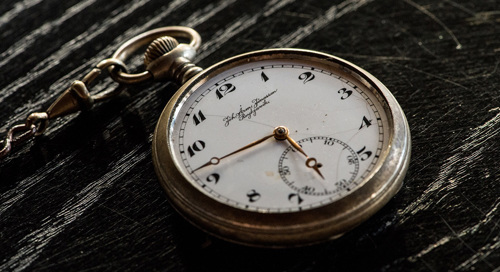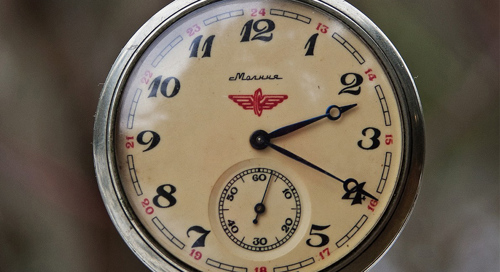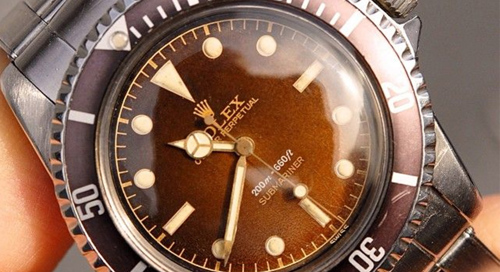The Art of Ageing: A Guide to Vintage Watch Patina
Should you preserve patina on your vintage watch? David Duggan discusses the pros and cons of this natural ageing phenomenon.
Over the past few decades, the vintage watch market has seen an interesting aesthetic shift. According to Christie’s Auction House, the patina trend in watches represents a market evolution that’s set to stay. Many enthusiasts attribute the origins of patina’s popularity to the Japanese market, where, particularly amongst Rolex sports watches, the natural signs associated with ageing are considered highly desirable. The phenomenon has now spread globally, with the US market in particular demanding vintage watches that have not been cleaned or restored in any way.
There’s no doubt that the presence of patina can significantly increase the value of a pre-owned luxury timepiece. Deciding whether to preserve your watch’s natural finish is a therefore crucial decision – but it’s also a matter of subjective judgement. Get this one wrong and you could potentially knock thousands off the value of your vintage watch investment. Get it right, and you could enhance not just the value of your watch, but your overall enjoyment of your treasured possession.
![]()

So, how do you decide when, why and how to treat a patina finish on your watch? One to Watch spoke to David Duggan to get his expert view on how to make these important decisions.
What is patina?
Put simply, patina is a natural oxidisation process that occurs over time on metals, amongst other natural materials. It creates a thin layer that can render in a variety of colours – from the classic green finish we all recognise on copper to deep neutral shades and even rainbow hues. A patina effect can also be recreated on modern items using what artists and metalworkers often call “distressed” or “applied” patina. That’s an area to be wary of in the vintage watch market – but more on that in a moment.
‘My first experience of patina was when I worked for my brother as a coin dealer in the 1970s,’ David recalls. ‘We saw it regularly in coins that were stored away to avoid exposure to daylight. Typically, when a client was looking to sell a collection – perhaps inherited from a loved one – their instinct would be to clean the coins before bringing them to us. Sadly, that’s a big mistake. Natural patina enhances the value of coins greatly, but people often don’t realise that when they take the plunge and get trigger happy with the silver dip. It’ s such a shame, it can quite easily reduce the collection’s value by up to fifty percent.’
Will patina make my watch more valuable?
When it comes to watches, though, the parameters for preserving versus cleaning are not so simple. ‘There’s no doubt that when I see, for example, a vintage Patek Philippe that has never been polished, it can look really beautiful,’ says David. ‘And that’s certainly the market’s preference at the moment. In the case of coins, I would always say leave them well alone – but not necessarily with watches. Yes, we invest in vintage watches in the hope that they will accumulate value. But we also purchase them as something to wear and enjoy. Patina can be stunning, but it can also look quite scruffy and, if that’s the case, my view is that there’s no pleasure in wearing what appears on the surface to be just a grubby old watch!’
What’s more, David adds, whether you choose to preserve patina or restore your watch to its original state also depends on which components of the watch are affected. “Any watch with a steel, gold, rose gold, silver or platinum strap or case is likely to develop patina,” he explains. “If your watch has a murky, muddy finish that you don’t like, my recommendation would be to engage an experienced watch service centre to perform a careful restoration on these components. But be wary of allowing any technician to put your watch into an electric watch cleaner! This technique does have its place, but If a watch is polished constantly by a buffing machine, the hallmark will start to wear down. I see a lot of lot of old watches where the hallmarks have been nearly rubbed out which, of course, makes it more difficult to verify their authenticity. An intricate, manual restoration process will ensure that your watch remains an eye catching pleasure to wear, whilst allowing your technician the discretion to judge whether elements of the patina should be kept to preserve the history and value of the piece. This is a skilled art, as well as a science.’
![]()

The delights and dangers of patina dials
Watch dials, though, are a different ballgame. ‘Particularly in the case of Rolex and Patek Philippe, I wouldn’t touch the dial at all,’ David advises. “We first noticed this with the old Rolex steel sports watches. About twenty years ago, they started to tone over and acquire some really beautiful and interesting effects. Nowadays, that can add massive value to the watch. A rare 1950s Rolex Submariner, for example, could be worth £50,000 with a normal looking dial. If it has a beautiful brown patina on it, it can be worth double! And dials that have been have cleaned can look really awful. If you have fallen in love with a 1940s watch, precisely because of its vintage nature, cleaning the dial can kill its character. So, a case or strap can usually be sympathetically restored, but with a dial, unless it's really badly marked, I would say avoid restoration on 99% of occasions.’
The charm that comes with a patina dial is not without its perils, according to David. ‘What we call tropical dials (where the patina takes on a rich brown hue) are particularly desirable – if you find one, or you already own one, count yourself lucky. They command astonishing premiums – your budget can easily double if you want to add a tropical dial to your collection.

![]()
Unfortunately, watch forgers are now mastering the art of recreating the tropical dial effect. Knowing how to spot a fake Rolex or Patek Philippe is tricky enough anyway, but it’s even harder when there’s an apparently natural aging process on display. Especially when you’re looking to purchase a tropical dial watch, it’s essential to go through a watch dealer that you trust 100%, or buy at auction, and only if the auction states that it's an original, untouched dial. The same applies to outer bezels. Often, on watches from the 1950s and 60s, these lose their colour over time. This is known as a ghost bezel. Personally, the effect is not to my taste, but it’s another element that is significantly driving values up. So, my overall advice would be: consider restoration if you don’t like the patina effect on your watch’s case or strap – but if you’ve got a watch with patina present on the dial or bezel, leave it alone!’
Patina preservation: David’s top tips
Balancing all of these considerations can be confusing and - given the dramatic effect that the right patina can have on your watch’s price tag – these are not decisions to be taken lightly. So, here are David’s three key points to remember if your watch is starting to display the natural signs of ageing:
Engage the experts: ‘Whether to restore, clean or simply leave a patina finish on your watch is not a decision you should make alone. A seasoned vintage watch expert will help you to assess the level and quality of the patina. They’ll also have their ear to the ground and will know which finishes are particularly desirable. So, they will be able to advise you as to the best course of action to preserve your watch’s value and integrity.’
Seek restoration, not obliteration: ‘Although my personal preference is to wear a clean, well presented watch, you don’t want to ruin its character through clumsy, automated cleaning techniques. Seek out an experienced technician who specialises in sympathetic, manual restoration. They will discuss your preferences and find the right way to bring the watch back to its former glory, without wiping out any elements that may build value now or in the future.’
Leave the dial alone! ‘If you’re not specific in your instructions, an over-zealous technician may take matters into their own hands. So, whenever you put your watch in for any kind of service or repair, make sure you clearly stipulate that the dial is not to be cleaned in any way, and that you wish to keep the patina effect in its natural state.’
![]()

If you have a vintage watch with a patina effect and you are interested in restoring, cleaning, or valuing the piece, David Duggan Watches is here to help you. Our showroom is temporarily closed due to Covid-19, but we are available by telephone for all enquiries about buying, selling, and servicing. Simply telephone us on 0207 491 1675 or 020 7491 1362 and we will be delighted to help.




